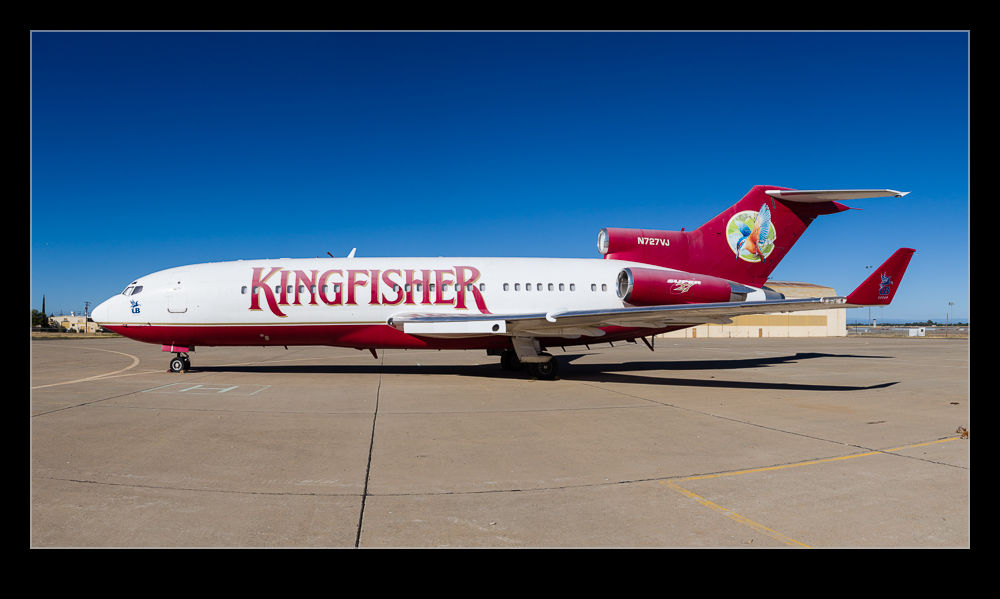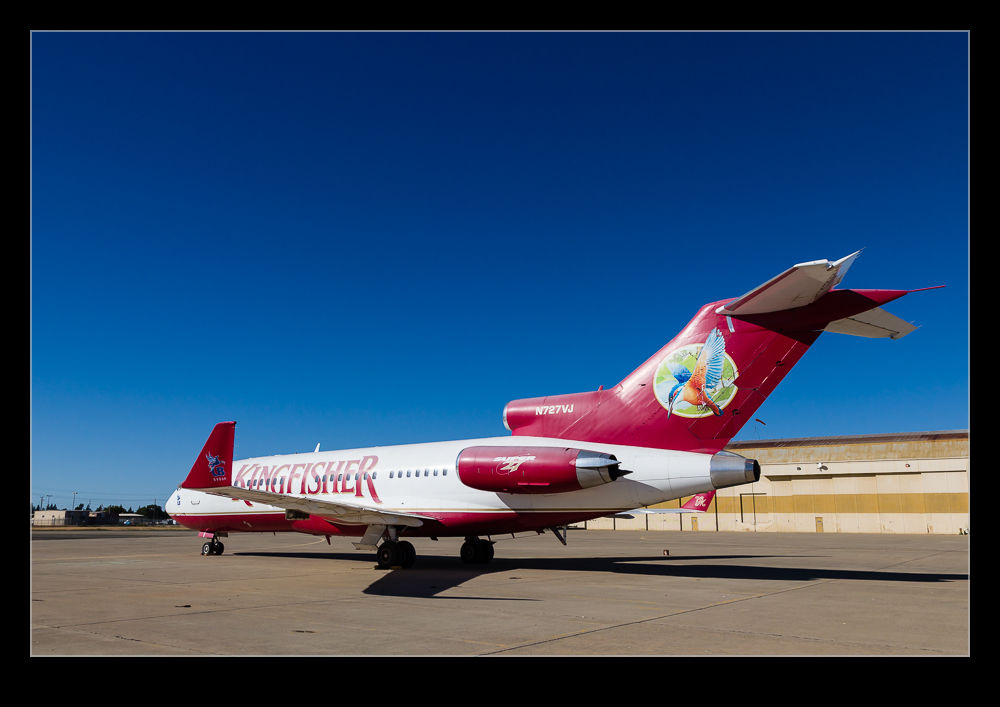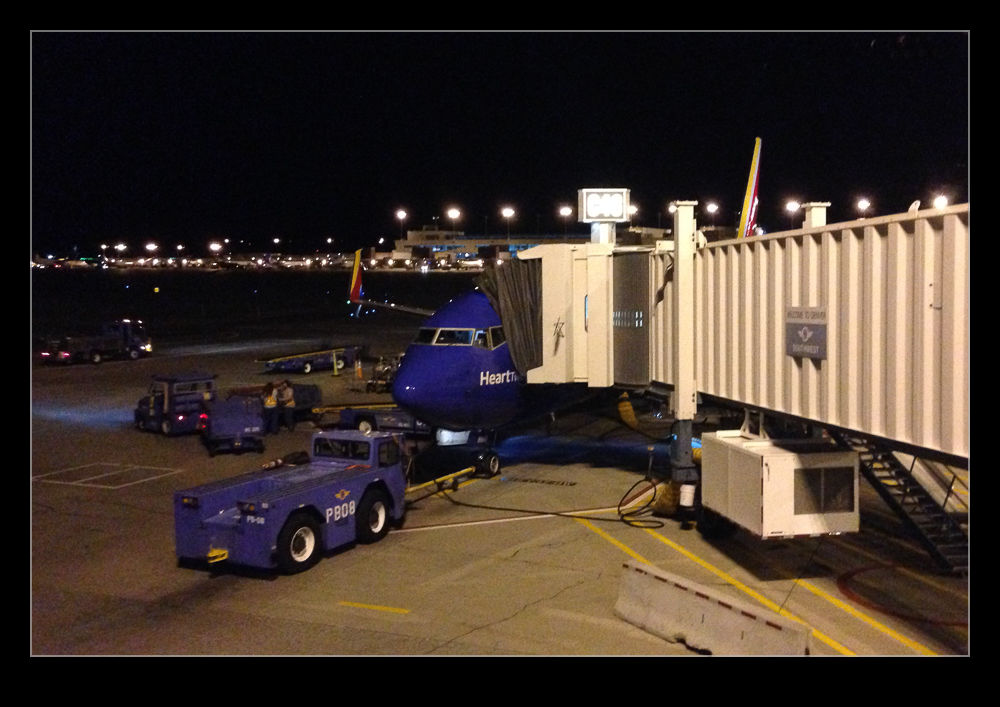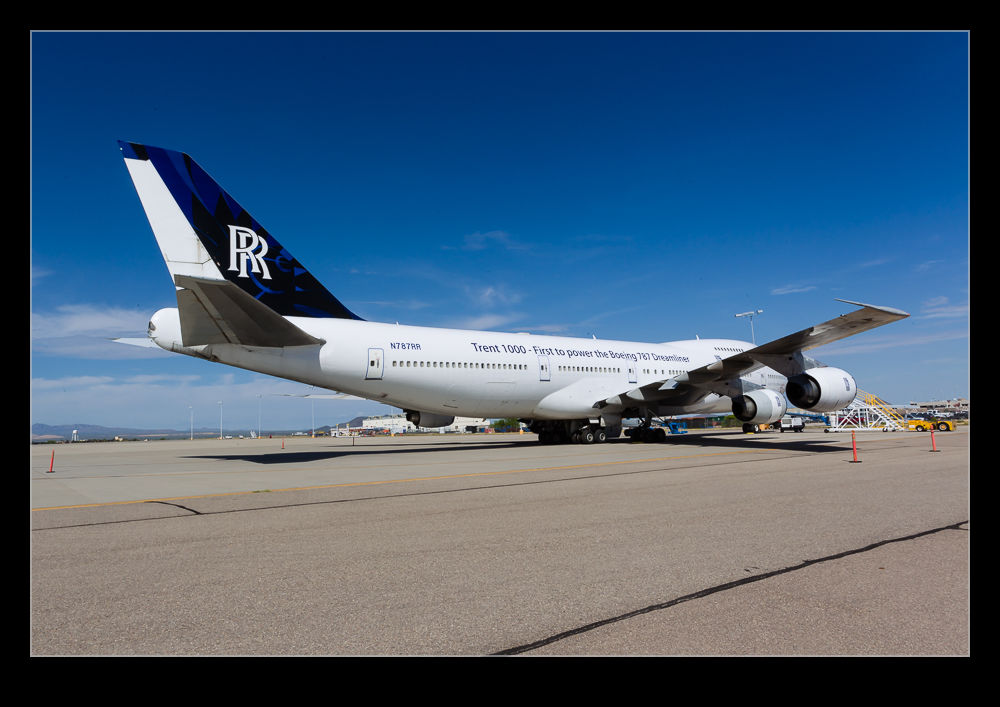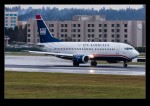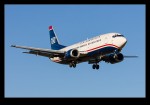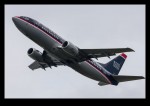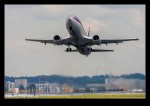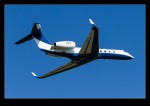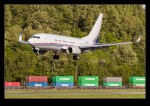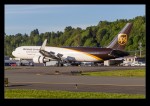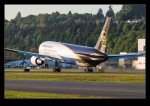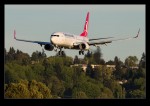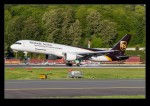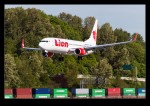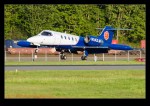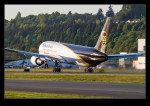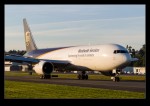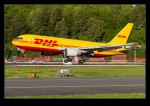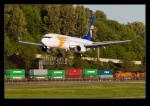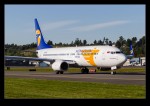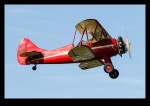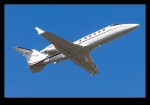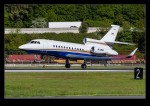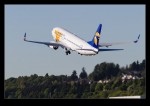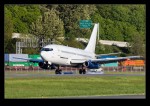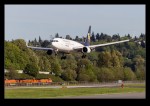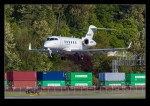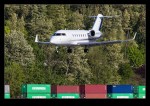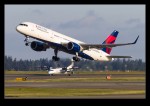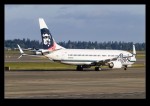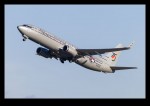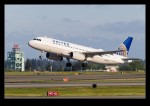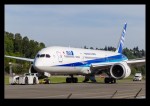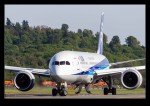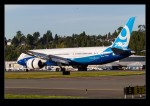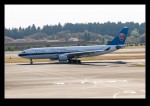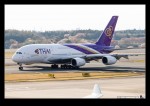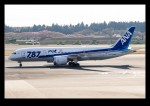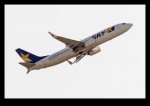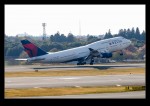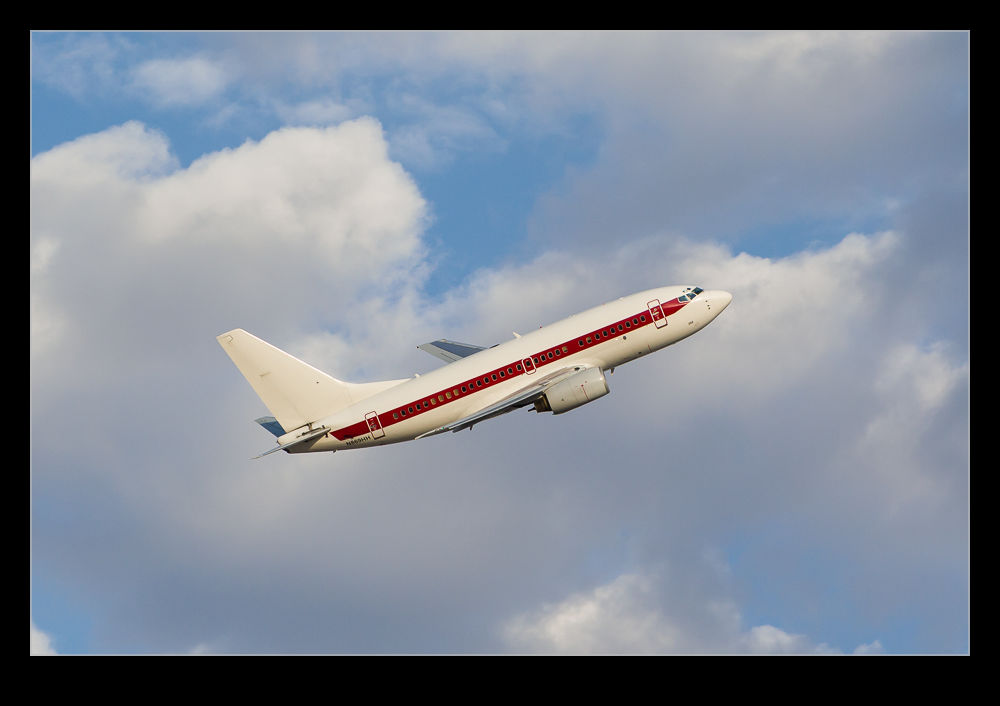 The shuttle of flights run out of McCarran Airport, Las Vegas by private contractors for various departments of the US Government are known as the Janets. Previously operated using Boeing 737-200s, the flights have now been upgraded to 737-600s, probably as a result of the low price of these jets given their lack of popularity with airlines. They operate a pretty busy schedule at certain times of day. The flights file a plan to a location and then cancel it en route as they divert to whatever secret installation that is their true destination. Paul, Chris and I decided to try and find a good location to catch one as it departs since they make a tight turn out and should have good light in the evening. Several arrived while we were there and we were too late for one of the departures but we did catch one of them heading out. The light ended up being very favorable.
The shuttle of flights run out of McCarran Airport, Las Vegas by private contractors for various departments of the US Government are known as the Janets. Previously operated using Boeing 737-200s, the flights have now been upgraded to 737-600s, probably as a result of the low price of these jets given their lack of popularity with airlines. They operate a pretty busy schedule at certain times of day. The flights file a plan to a location and then cancel it en route as they divert to whatever secret installation that is their true destination. Paul, Chris and I decided to try and find a good location to catch one as it departs since they make a tight turn out and should have good light in the evening. Several arrived while we were there and we were too late for one of the departures but we did catch one of them heading out. The light ended up being very favorable.
Tag Archives: airliner
Vijay’s 727
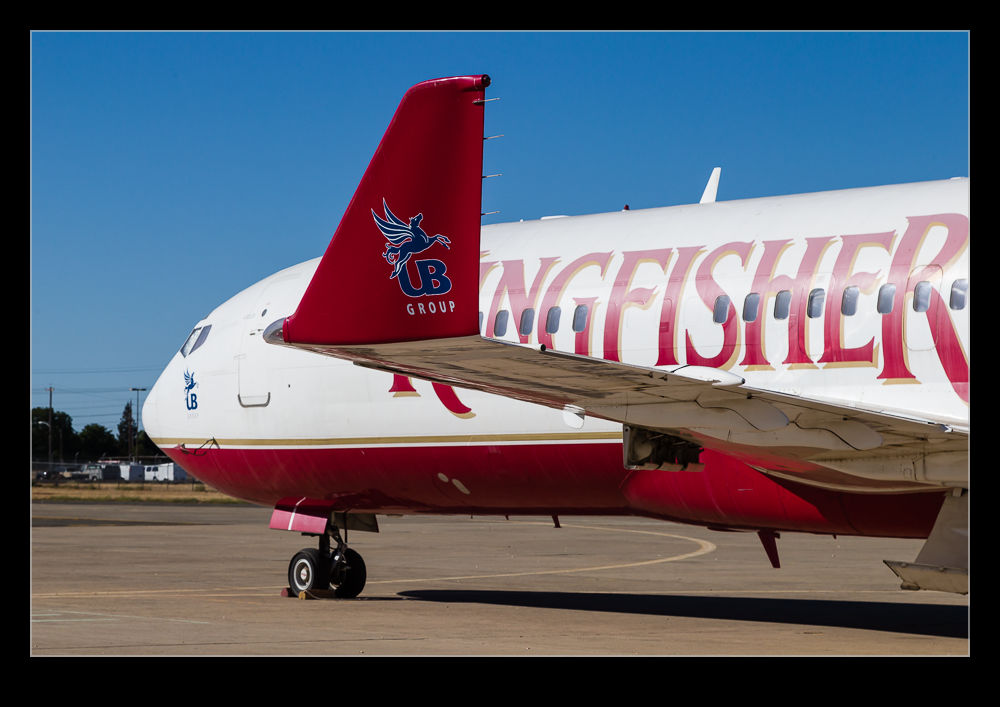 Paul and I had a day of exploring and part of this took us up to Sacramento. We checked out things at Mather to see what was going on. Often the interesting things are not what is flying but what is parked up and this proved to be the case with a Boeing 727. It was parked alone at one end of the field. The area it was parked in was kind of interesting as we stopped the car on what had clearly once been a hangar which was now demolished. We were trying to work out how big the hangar was and what the USAF might have kept in it when Mather was an active base. However, the 727 was our primary focus. It was in Kingfisher colors and carried the registration N727VJ. The boss of Kingfisher is Vijay Mallya so this was obviously once his personal jet. It has winglets fitted but the paint looked a bit faded so it might have been out of use for some time. I suspect he has something a bit newer these days.
Paul and I had a day of exploring and part of this took us up to Sacramento. We checked out things at Mather to see what was going on. Often the interesting things are not what is flying but what is parked up and this proved to be the case with a Boeing 727. It was parked alone at one end of the field. The area it was parked in was kind of interesting as we stopped the car on what had clearly once been a hangar which was now demolished. We were trying to work out how big the hangar was and what the USAF might have kept in it when Mather was an active base. However, the 727 was our primary focus. It was in Kingfisher colors and carried the registration N727VJ. The boss of Kingfisher is Vijay Mallya so this was obviously once his personal jet. It has winglets fitted but the paint looked a bit faded so it might have been out of use for some time. I suspect he has something a bit newer these days.
New Southwest Jets
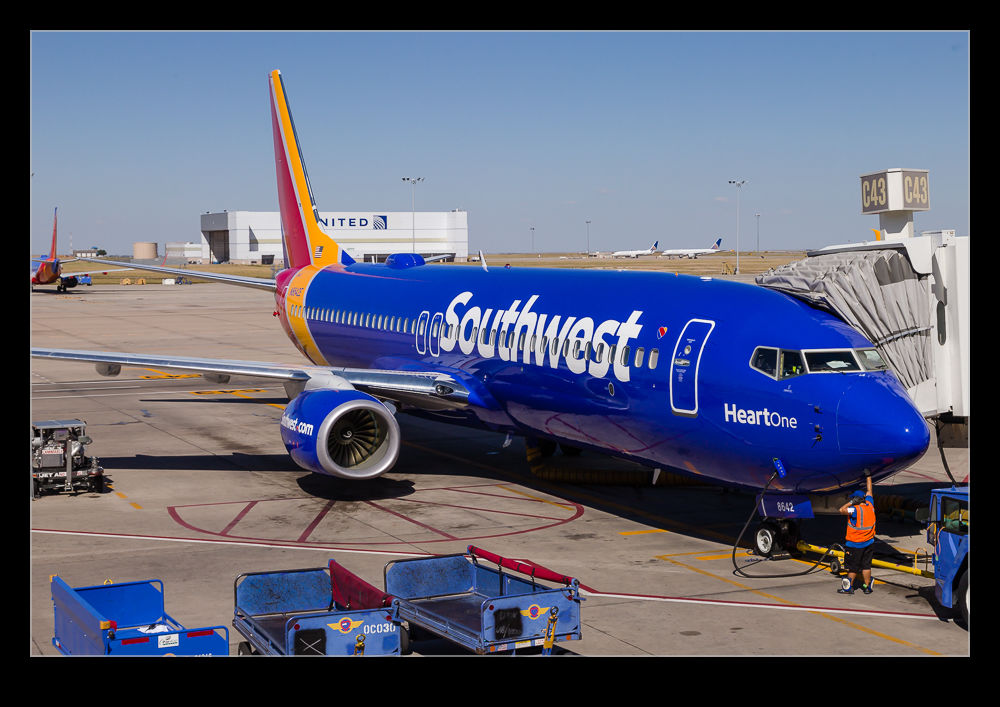 Southwest Airlines recently unveiled their new livery for their fleet. The scheme was first put on one of their newest 737-800 jets which also includes the new scimitar winglet configuration from APB. I was curious when I might get to see one for real. I knew of two jets that were out in the wild with the original names Heart One and Heart Two. While I was interested to get a shot of one of them, I figured it wouldn’t be too long before there were tons of them around and it wouldn’t be a big deal so I didn’t go out of my way to see one.
Southwest Airlines recently unveiled their new livery for their fleet. The scheme was first put on one of their newest 737-800 jets which also includes the new scimitar winglet configuration from APB. I was curious when I might get to see one for real. I knew of two jets that were out in the wild with the original names Heart One and Heart Two. While I was interested to get a shot of one of them, I figured it wouldn’t be too long before there were tons of them around and it wouldn’t be a big deal so I didn’t go out of my way to see one.
 Then, they came to me – well, almost. I was taking a trip last week that took me through Denver in both directions. I arrived at DIA on the outbound portion of my leg and there on the gate across from my next flight was Heart One. Shooting through airport glass isn’t great but it would do. I just had to wait until the servicing vehicles were done and then I could get a shot.
Then, they came to me – well, almost. I was taking a trip last week that took me through Denver in both directions. I arrived at DIA on the outbound portion of my leg and there on the gate across from my next flight was Heart One. Shooting through airport glass isn’t great but it would do. I just had to wait until the servicing vehicles were done and then I could get a shot.
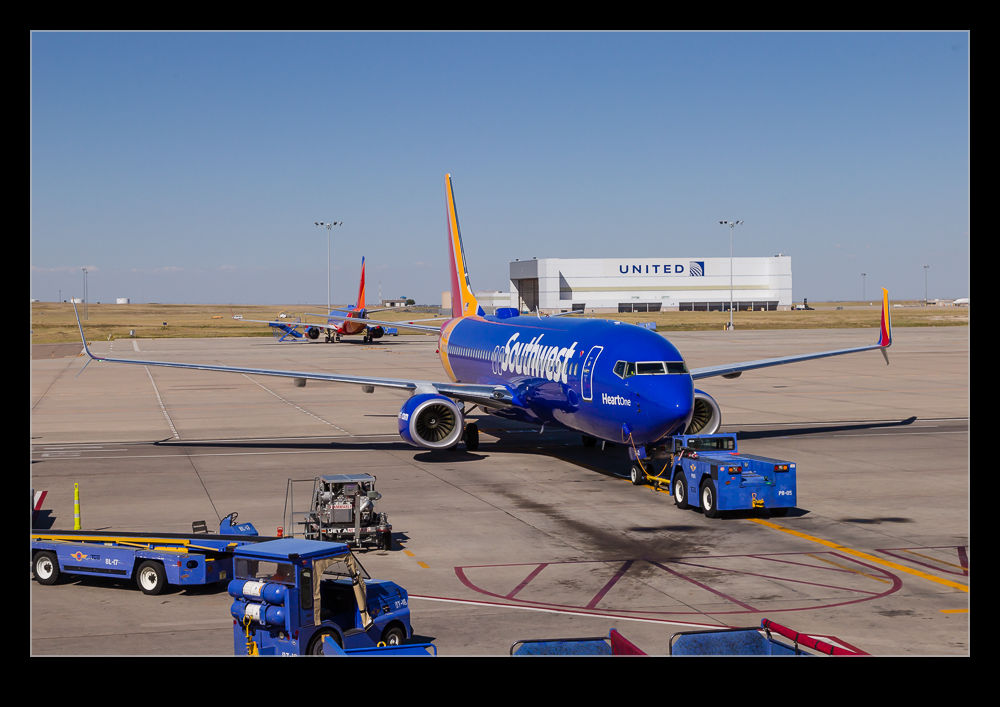 A day later I was coming back through DIA late in the evening. I get to my gate and there is my jet for the next sector. It is Heart Two. It was dark, the jet was mainly obscured by the jet-bridge and I didn’t think it worth much effort so an iPhone shot is all there is to show for it but I ended up with both of them in two days without any planning on my part.
A day later I was coming back through DIA late in the evening. I get to my gate and there is my jet for the next sector. It is Heart Two. It was dark, the jet was mainly obscured by the jet-bridge and I didn’t think it worth much effort so an iPhone shot is all there is to show for it but I ended up with both of them in two days without any planning on my part.
Rolls Royce Testbed
 Something I hadn’t seen before was the Boeing 747 that Rolls Royce own and use as a testbed for the Trent 1000 engine on the Boeing 787. Appropriately registered N787RR, this was parked up close to a road. I actually spotted it first just as we landed. It was already dark and I saw the outline of the plane but had no idea what it was or why it was there. However, after picking up my rental car I came out near its parking spot so took a pass by. Being dark, there was nothing much to be shot but I decided to check it out again when it was daylight.
Something I hadn’t seen before was the Boeing 747 that Rolls Royce own and use as a testbed for the Trent 1000 engine on the Boeing 787. Appropriately registered N787RR, this was parked up close to a road. I actually spotted it first just as we landed. It was already dark and I saw the outline of the plane but had no idea what it was or why it was there. However, after picking up my rental car I came out near its parking spot so took a pass by. Being dark, there was nothing much to be shot but I decided to check it out again when it was daylight.
 Apparently, this airframe had been sitting without the test engine for a while but there is now an engine fitted. Whether this means that they have been flying recently or are planning to soon I do not know. Unfortunately the test engine was on the side away from the road so was harder to show well in a shot. However, I still managed to get a few shots.
Apparently, this airframe had been sitting without the test engine for a while but there is now an engine fitted. Whether this means that they have been flying recently or are planning to soon I do not know. Unfortunately the test engine was on the side away from the road so was harder to show well in a shot. However, I still managed to get a few shots.
Goodbye USAirways 737-400
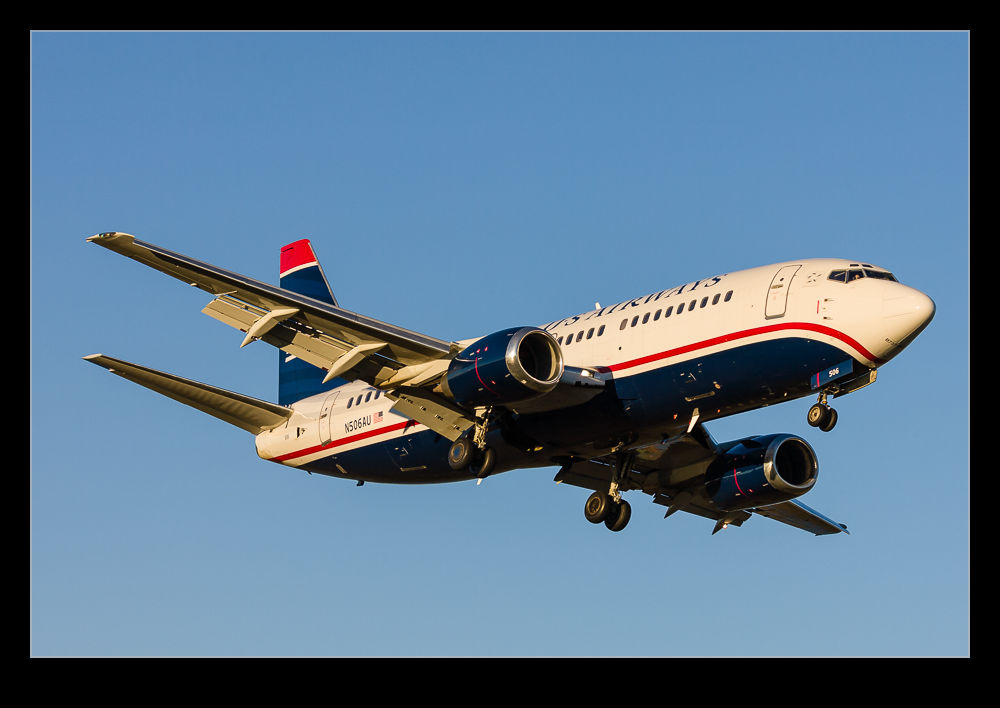 There are some airlines in the US that I have spent a lot of time with and there are others that have only been an occasional feature of my travel. USAirways is one that I did not use a great deal since I didn’t live in one of their core markets. However, I did sometimes find myself on one of their planes and I have certainly seen plenty of them around.
There are some airlines in the US that I have spent a lot of time with and there are others that have only been an occasional feature of my travel. USAirways is one that I did not use a great deal since I didn’t live in one of their core markets. However, I did sometimes find myself on one of their planes and I have certainly seen plenty of them around.
 Their fleet has included a lot of the A320 family but for a long time the 737 was a big part of operations with the 737-400 a regular sight. Now, their time has come and the last flight has taken place. This prompted me to dig through the collection to see what I had of them. It seems that most of my shots come from the Washington DC area but it was nice to have older and newer schemes on the jets.
Their fleet has included a lot of the A320 family but for a long time the 737 was a big part of operations with the 737-400 a regular sight. Now, their time has come and the last flight has taken place. This prompted me to dig through the collection to see what I had of them. It seems that most of my shots come from the Washington DC area but it was nice to have older and newer schemes on the jets.
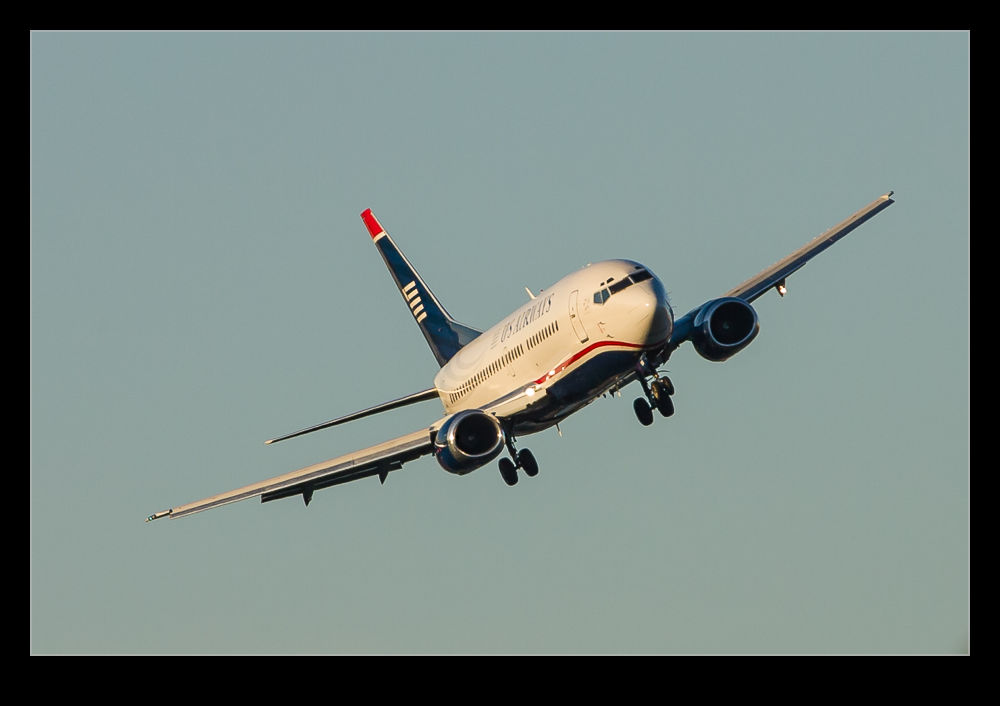 Here are a few of the jets that have now either gone to another home or have ended up as spares for the rapidly diminishing fleet of what became known as 737 Classics (although the 100 and 200 series jets might cause an eyebrow to be raised at that description).
Here are a few of the jets that have now either gone to another home or have ended up as spares for the rapidly diminishing fleet of what became known as 737 Classics (although the 100 and 200 series jets might cause an eyebrow to be raised at that description).
Boeing Field
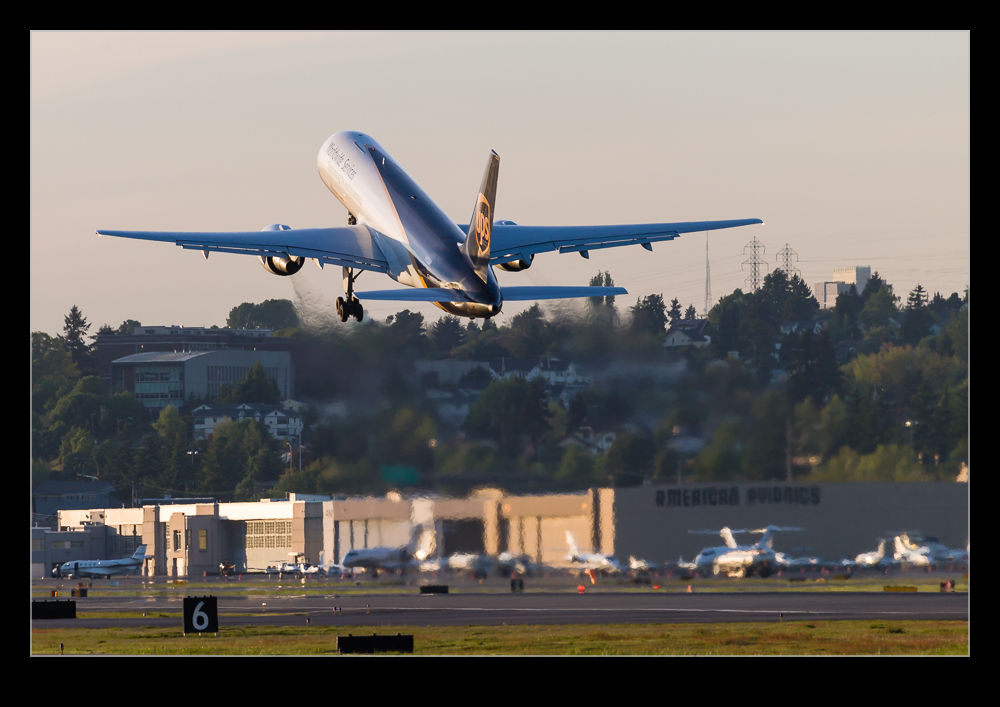 No great story for today’s post. I got some time to shoot at Boeing Field in the evening after a day of meetings and travel. Some of the interesting subjects got their own posts. Here are just a few shots of the other traffic that was coming in to the field. The evening light was fantastic and it was fun to watch the movements including some of the Boeing production traffic. Mongolian was a new airline for me. Sadly my timing was off and I didn’t get to see the Indian Navy P-8 on test. Never mind.
No great story for today’s post. I got some time to shoot at Boeing Field in the evening after a day of meetings and travel. Some of the interesting subjects got their own posts. Here are just a few shots of the other traffic that was coming in to the field. The evening light was fantastic and it was fun to watch the movements including some of the Boeing production traffic. Mongolian was a new airline for me. Sadly my timing was off and I didn’t get to see the Indian Navy P-8 on test. Never mind.
SeaTac
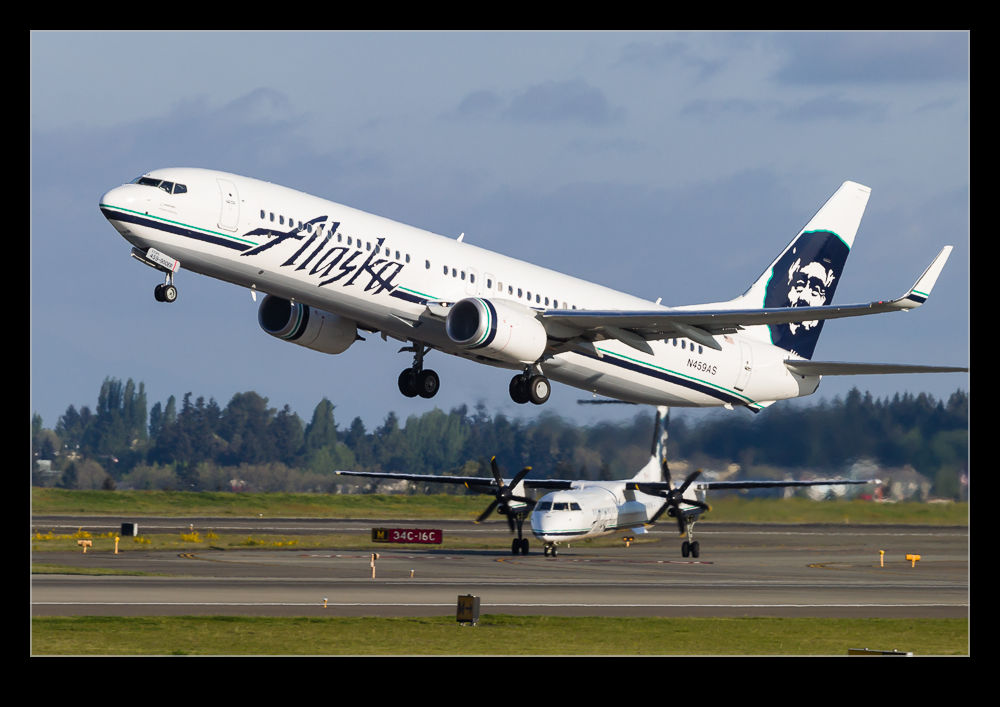 I had an early flight out of Seattle on my way back to the Bay Area. It was a nice morning and the planes were departing to the south. The terminal that Southwest operates from is towards the southern end of the airport so you get the aircraft passing you as they get airborne. I had given myself some margin for getting to the airport, checking in the rental car and getting the shuttle to the terminal and everything had gone smoothly so I actually had a bit of time on my hands. Also, on the shuttle I had seen an Alaska 737 in 75th anniversary markings on a gate so I thought I might have a chance to get a shot of it if it wasn’t going straight out.
I had an early flight out of Seattle on my way back to the Bay Area. It was a nice morning and the planes were departing to the south. The terminal that Southwest operates from is towards the southern end of the airport so you get the aircraft passing you as they get airborne. I had given myself some margin for getting to the airport, checking in the rental car and getting the shuttle to the terminal and everything had gone smoothly so I actually had a bit of time on my hands. Also, on the shuttle I had seen an Alaska 737 in 75th anniversary markings on a gate so I thought I might have a chance to get a shot of it if it wasn’t going straight out.
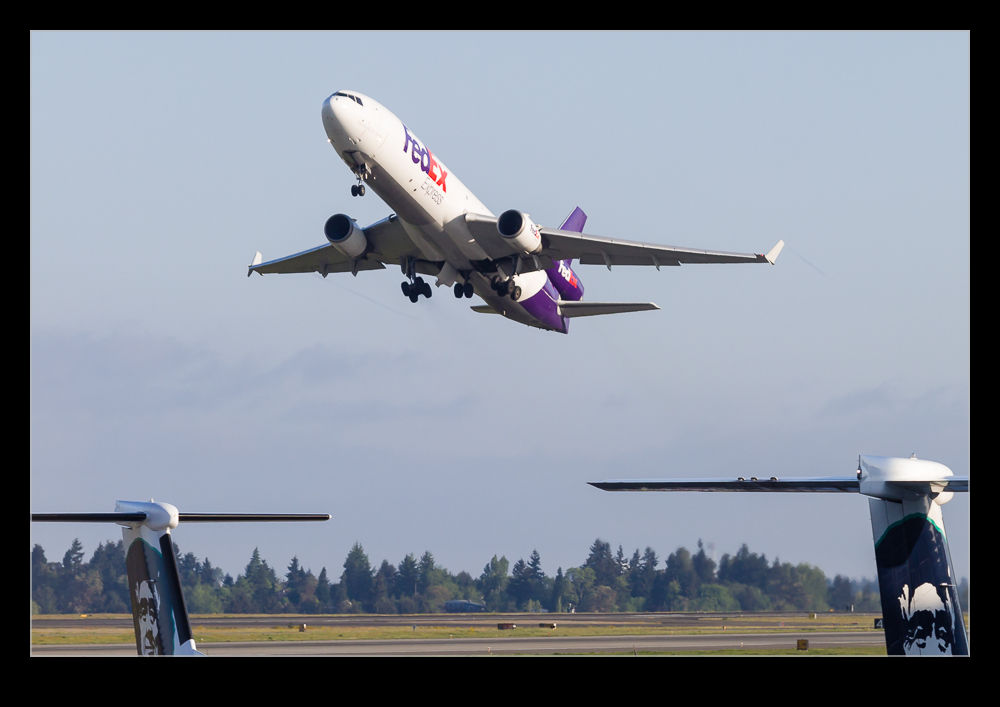 There is a kink in the pier as you head to Southwest’s gates that gives you a good view across the field and is not obstructed by jet bridges. Moreover, it isn’t a busy part of the terminal so waiting there and getting some shots is practical. Of course, you are shooting through some thick glazing but, even so, I was pleasantly surprised that the shots were not too badly compromised. The only problem was that the Q400s that Horizon operates from the central part of the terminal throw of some exhaust distortion which ruins what could be some good angles.
There is a kink in the pier as you head to Southwest’s gates that gives you a good view across the field and is not obstructed by jet bridges. Moreover, it isn’t a busy part of the terminal so waiting there and getting some shots is practical. Of course, you are shooting through some thick glazing but, even so, I was pleasantly surprised that the shots were not too badly compromised. The only problem was that the Q400s that Horizon operates from the central part of the terminal throw of some exhaust distortion which ruins what could be some good angles.
 I had to make sure I didn’t forget my own flight but I did get some nice shots. The Alaska anniversary jet did time its departure well for me and I was even more pleasantly surprised when one of their 737s came by sporting the new scimitar winglets from APB. That was the first time I had seen some for real. A nice bonus before heading home.
I had to make sure I didn’t forget my own flight but I did get some nice shots. The Alaska anniversary jet did time its departure well for me and I was even more pleasantly surprised when one of their 737s came by sporting the new scimitar winglets from APB. That was the first time I had seen some for real. A nice bonus before heading home.
Boeing 787-9
 One evening I arrived at Boeing Field to see what was moving. Just as I got there, a 787 was rolling out on landing. Since the wind was in the opposite direction to my previous visit, I didn’t see it land but it rolled down to our end of the field. Interestingly, the gear doors were down and the RAT was deployed. These RAT is usually tested on early production test flights so I suspect this was the reason but the gear doors being down is one that had me wondering. The aircraft, which was finished in the livery of All Nippon Airways, taxied off the runway and turned on to the taxiway where it promptly shut down. It hadn’t even straightened up and the nosewheel was still at an angle. I have no idea whether this is normal practice or if something unusual had happened.
One evening I arrived at Boeing Field to see what was moving. Just as I got there, a 787 was rolling out on landing. Since the wind was in the opposite direction to my previous visit, I didn’t see it land but it rolled down to our end of the field. Interestingly, the gear doors were down and the RAT was deployed. These RAT is usually tested on early production test flights so I suspect this was the reason but the gear doors being down is one that had me wondering. The aircraft, which was finished in the livery of All Nippon Airways, taxied off the runway and turned on to the taxiway where it promptly shut down. It hadn’t even straightened up and the nosewheel was still at an angle. I have no idea whether this is normal practice or if something unusual had happened.
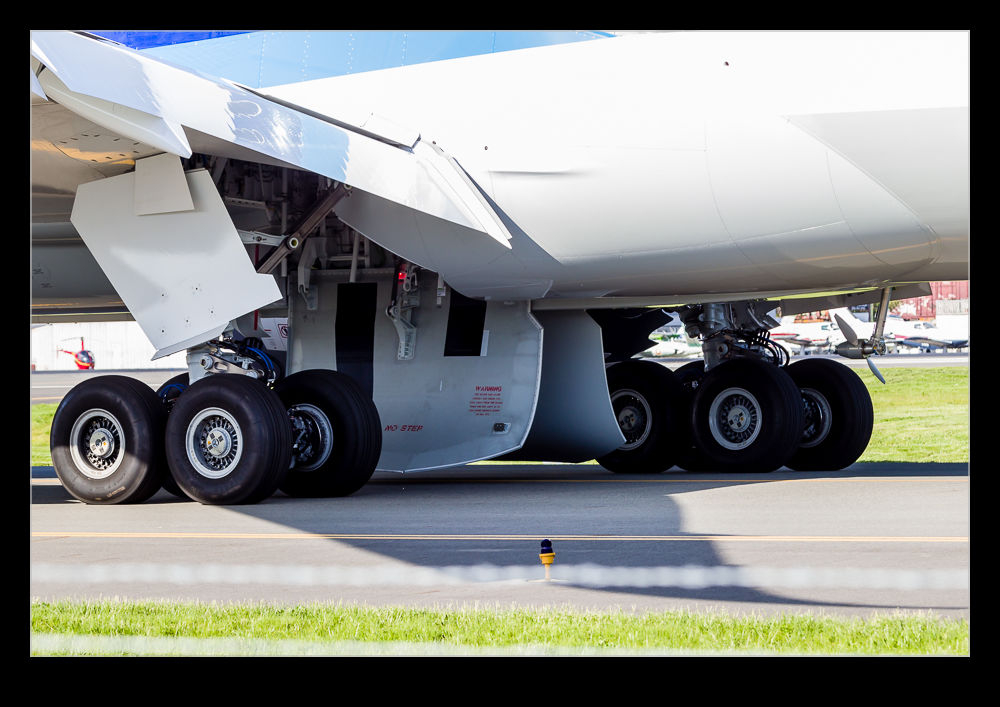 Whatever the reason, it sat there for quite a while until a Boeing team showed up to recover it. Interestingly, they brought an ambulance with them although there didn’t appear to be any need for one. This could also be a standard procedure or maybe something unusual had occurred. I doubt I will ever know. In all of this time, it never occurred to me that this would be other than a regular production 787. However, checking into this later, this was in fact one of the 787-9 and so something new for me. In truth, it wasn’t entirely new. The previous evening one of the dash 9 test aircraft had come back in while I was there so this trip got me my first two airborne dash 9s. I had seen a test aircraft on the ground before but that seems like a bit of a cheat in comparison.
Whatever the reason, it sat there for quite a while until a Boeing team showed up to recover it. Interestingly, they brought an ambulance with them although there didn’t appear to be any need for one. This could also be a standard procedure or maybe something unusual had occurred. I doubt I will ever know. In all of this time, it never occurred to me that this would be other than a regular production 787. However, checking into this later, this was in fact one of the 787-9 and so something new for me. In truth, it wasn’t entirely new. The previous evening one of the dash 9 test aircraft had come back in while I was there so this trip got me my first two airborne dash 9s. I had seen a test aircraft on the ground before but that seems like a bit of a cheat in comparison.
Narita
 My trip back home departed from Narita Airport. The journey out there was swift so I got there with some time to spare. Narita is one of the airports that still has a viewing terrace. Not only that, they provides holes in the wire fencing to stick your lens through! I wasn’t there for terribly long and it was the afternoon when the sun is pretty much in your face. However, it was a far nicer place to be than sitting at the gate. This was the side of the airport where the US airlines tended to operate so I saw a lot of planes that I can see at home. However, there were some interesting operators departing from the runway on that side of the field that I hadn’t seen before so I sat back and enjoyed the new sights along with the old.
My trip back home departed from Narita Airport. The journey out there was swift so I got there with some time to spare. Narita is one of the airports that still has a viewing terrace. Not only that, they provides holes in the wire fencing to stick your lens through! I wasn’t there for terribly long and it was the afternoon when the sun is pretty much in your face. However, it was a far nicer place to be than sitting at the gate. This was the side of the airport where the US airlines tended to operate so I saw a lot of planes that I can see at home. However, there were some interesting operators departing from the runway on that side of the field that I hadn’t seen before so I sat back and enjoyed the new sights along with the old.
Boeing 777-300ER Main Gear
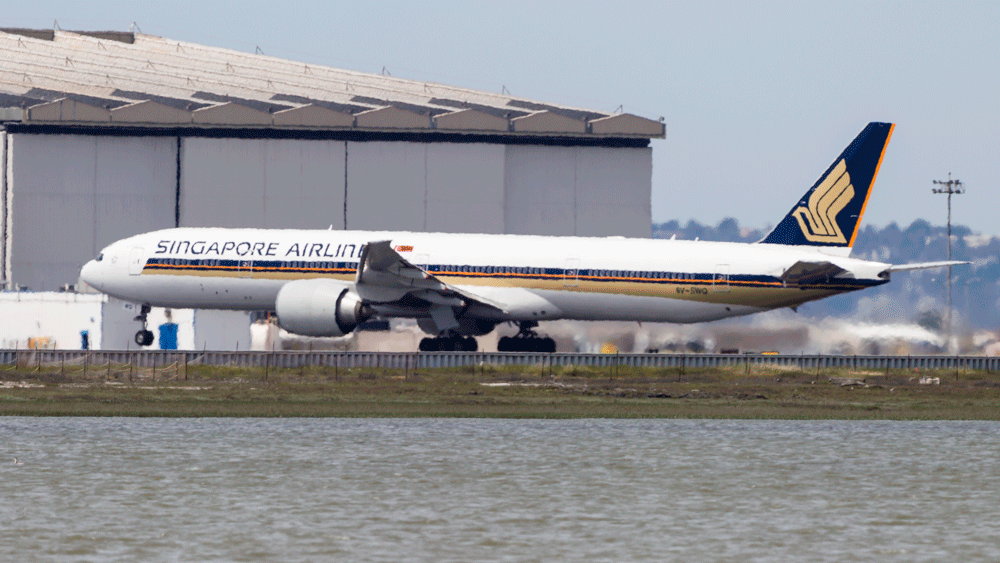 When Boeing launched the 777-300ER, they took the stretched fuselage of the 777-300, a model that didn’t sell particularly well and married it to the updated wing that made use of the fuel capacity of the outboard portion of the wing that had been left when the original concept of a folding wing was contemplated. The increased the weights of the jet, added far more powerful engines and, with the increased fuel capacity, came up with a winning formula that has done a very effective job of killing off the 747.
When Boeing launched the 777-300ER, they took the stretched fuselage of the 777-300, a model that didn’t sell particularly well and married it to the updated wing that made use of the fuel capacity of the outboard portion of the wing that had been left when the original concept of a folding wing was contemplated. The increased the weights of the jet, added far more powerful engines and, with the increased fuel capacity, came up with a winning formula that has done a very effective job of killing off the 747.
One problem that they had to deal with during development was runway length requirements for takeoff. Even with the bigger engines, the long fuselage limited rotation angles at takeoff and meant a higher takeoff speed was required which meant a longer runway requirement. Boeing came up with an interesting solution (after dumping some slightly more curious ideas). The main gear on the 777 has a triple axle bogie. Previously this had rotated about the pin attaching it to the main gear leg. Boeing’s solution was to lock the bogie level during takeoff.
The result of this is to have the rotation of the jet at takeoff to take place around the rear wheels of the bogie rather than the gear leg pin. The slight aft movement of the rotation point allows the aircraft to rotate slightly more nose up and gain a greater angle of attack. This gives slightly more lift for a given speed. This means an earlier takeoff and a shorter runway requirement.
I have tried many times to witness this at work. First, it happens pretty quickly. Second, I am often in a poor position to see the rotation point. Recently I was at SFO to pick up some people. I was getting a few shots prior to their flight arriving and a Singapore 777-300ER was taking off. The rotation point is quite far away (although, if you are in the terminal, you might have a good view) and the heat haze is a problem. However, I decided to get a sequence of shots anyway. Now, how to use them.
Heat haze is crappy on stills but less of an issue with moving images so I decided to animate the sequence. I imported all of the shots into Photoshop as layers in a single document via Lightroom. The hardest part was aligning them. I started at the bottom layer and then progressively made each layer above visible. I then changed the latest top layer blend mode to difference. This makes aligning them a lot easier since everything is black unless it is different. I was focused on the gear so used that as the reference as the fuselage rotated. Once each layer was in place, I changed the blend mode back to normal and moved to the next layer up.
Once they were all aligned, I used the animation timeline to make frames from each layer (and reversed the order since every time I do this they seem to be the wrong way around). Then I could crop in to get the overall view I was after and save the file. A Save for Web allows the generation of the animated GIF and we are done. The image at the top is the final result. It does allow you to see a bit of what is going on if you look closely although it is still a bit hard given the distance, the angle to the ground and the heat haze. I guess I will have to find a location closer next time.

